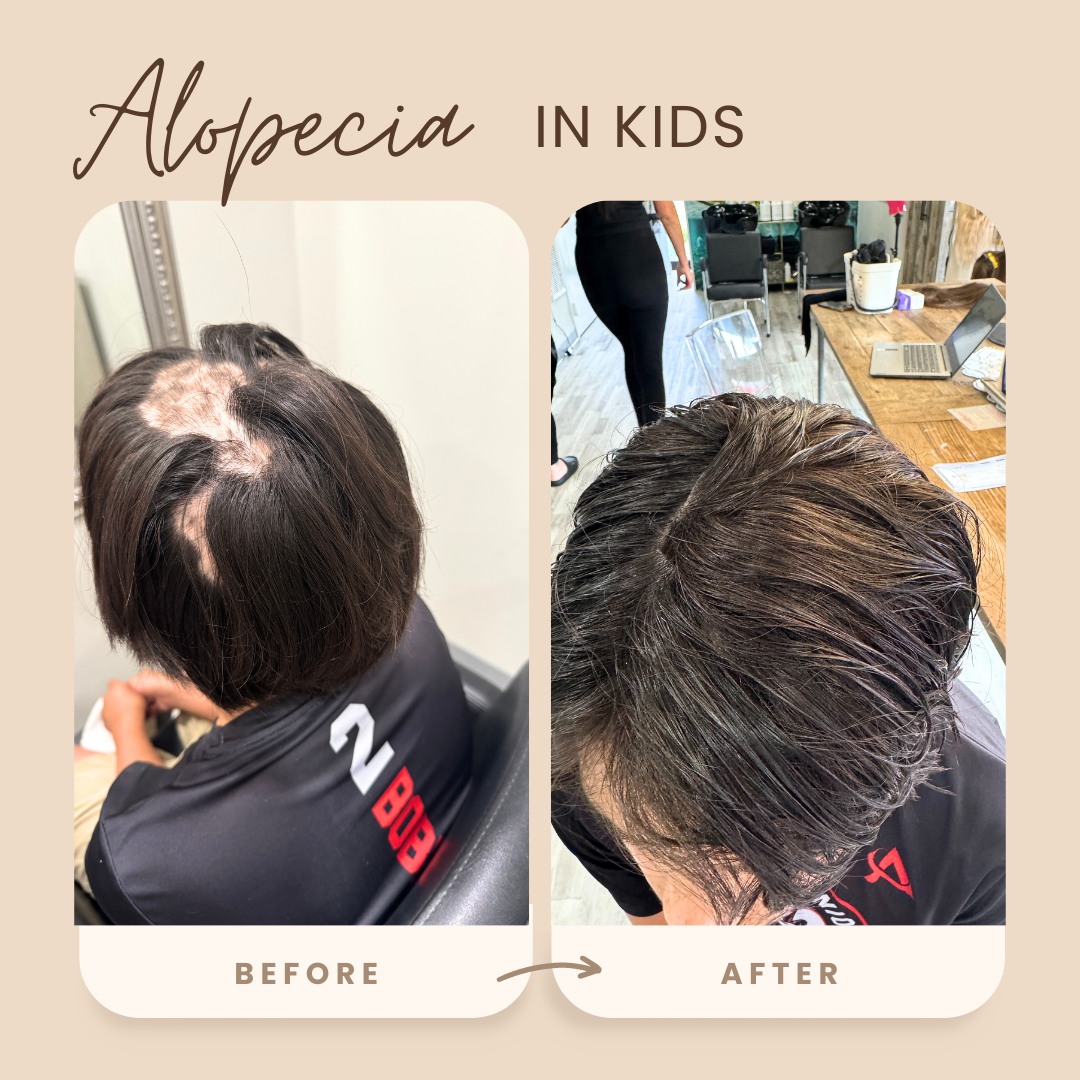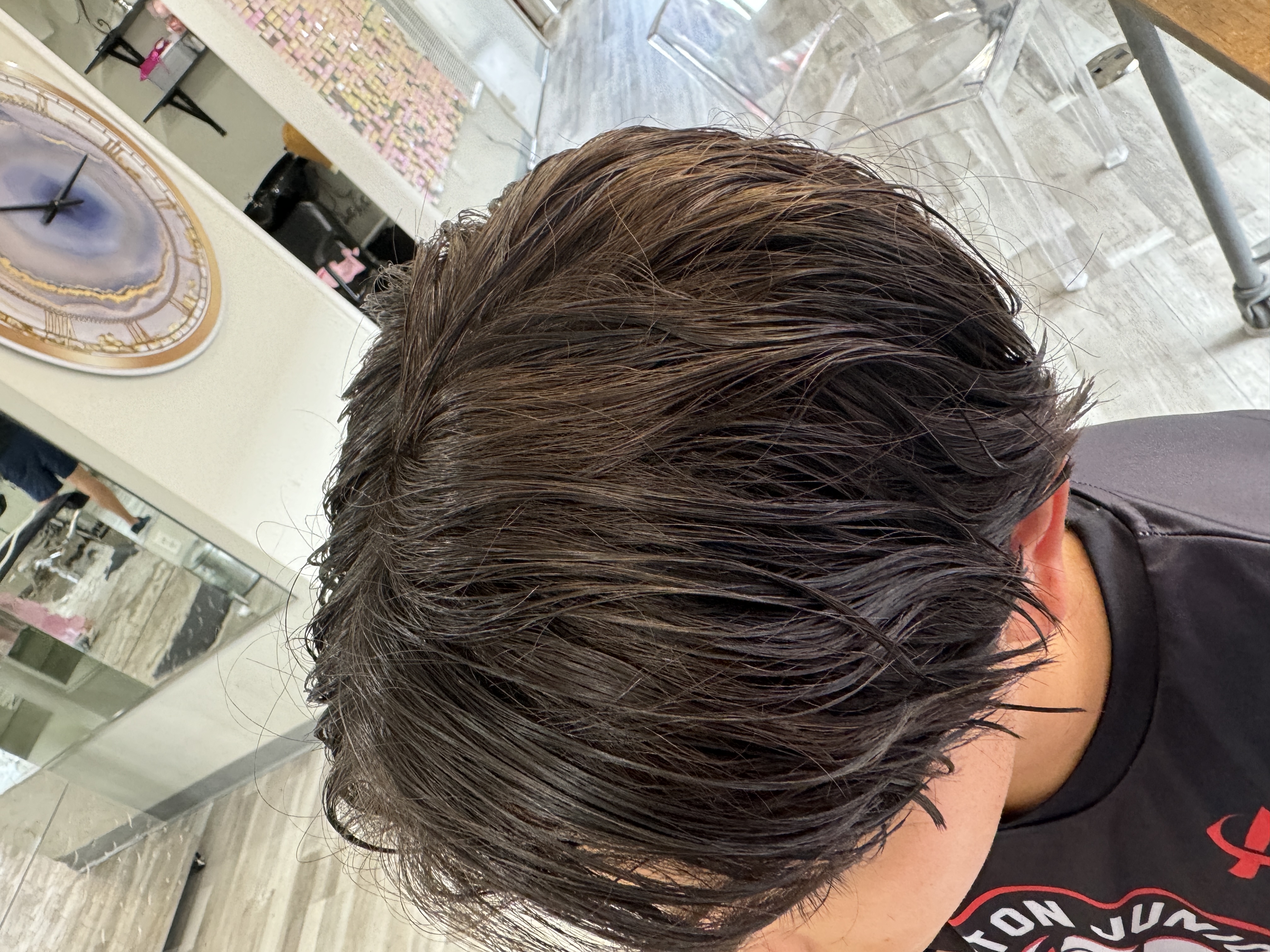Alopecia Areata in Children: Symptoms & Treatment Options
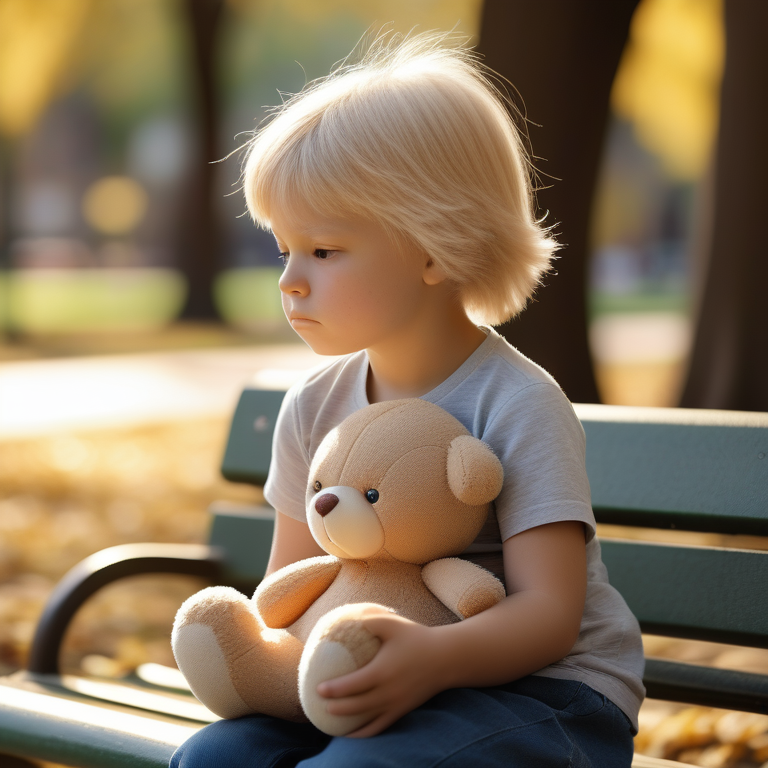
Key Highlights
Alopecia areata is an autoimmune disease that can cause hair loss in young children and adolescents.
- The condition is not contagious, and while the exact cause is unknown, genetic predisposition and environmental triggers are thought to play a role.
Common symptoms include round or oval bald patches on the scalp, sometimes appearing suddenly.
- Treatment options vary depending on the severity of the condition and may include topical medications, corticosteroids, or immunotherapy.
- Emotional support and open communication are crucial for children with alopecia areata to cope with hair loss's psychological effects.
Introduction
Alopecia areata is an autoimmune disease. It can affect people of all ages, even young children. This disease causes hair loss in round patches and is known as a form of hair loss. This happens because the immune system wrongly targets hair follicles and is often associated with other autoimmune conditions such as thyroid disease. In this blog post, we will look at the symptoms, causes, diagnosis, and treatment options for alopecia areata in children. We will also answer common questions to help you understand this condition better.
Understanding Alopecia Areata in Children
Alopecia areata is a condition where the immune system, which protects us from harm, mistakenly harms the hair follicles. This results in hair loss. It mostly happens on the scalp but can affect other areas of the body too.
For children, alopecia areata can be a tough experience. It is hard for both the child losing hair and their parents. It is key to know that this condition is not contagious. With the right support, information, and treatment, many kids, including older children, can see hair regrowth and continue to live happy, confident lives. However, it is important to note that the prognosis for pediatric alopecia areata can be unpredictable, with up to 50% of patients showing regrowth within one year without treatment. Relapse is also common, even after successful regrowth, and young age at first presentation is associated with a poor prognosis.
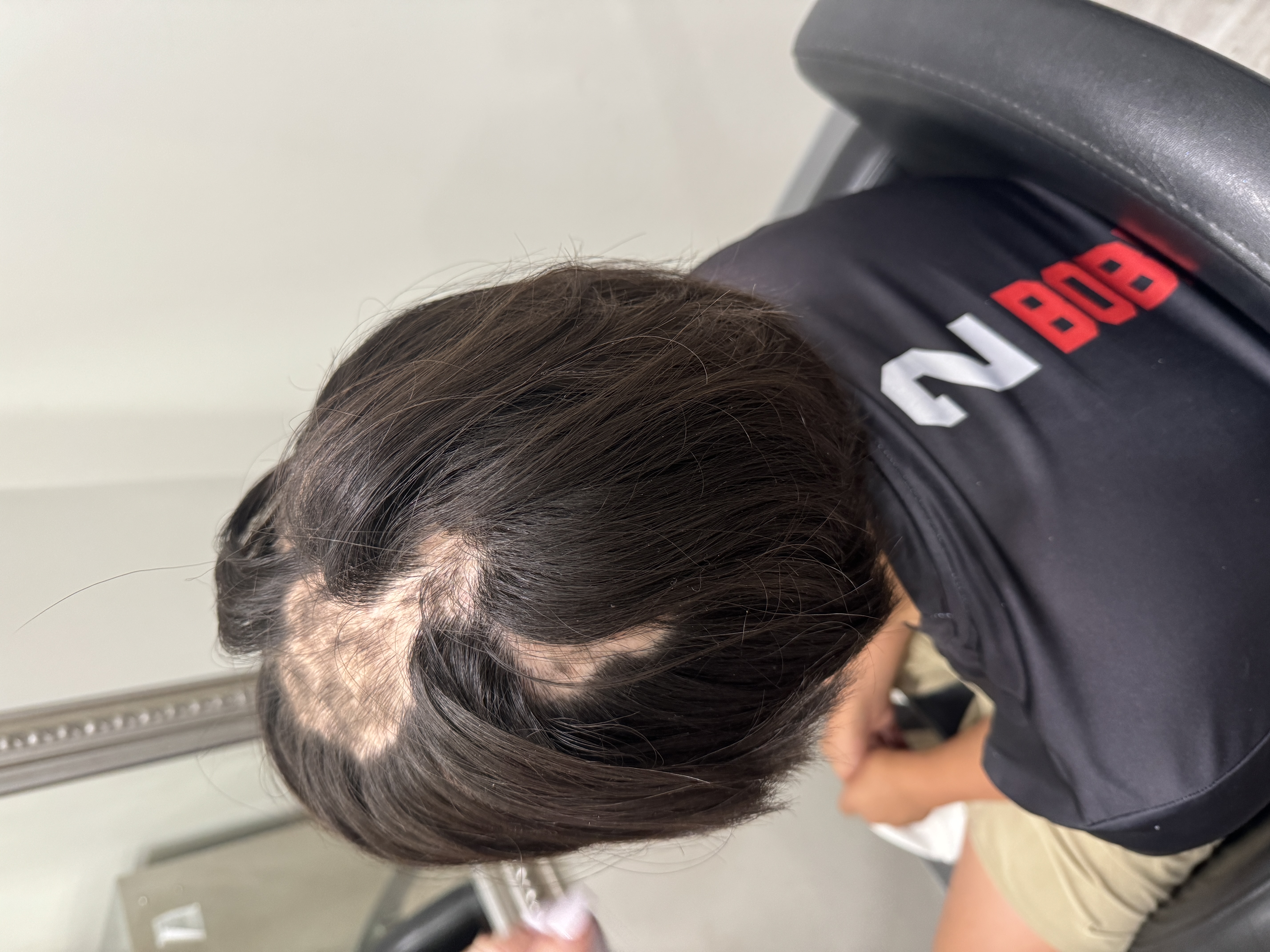
Defining Alopecia Areata: A Brief Overview
Alopecia areata is an autoimmune disorder. This means the immune system doesn't work properly. Instead of attacking germs like bacteria and viruses, it mistakenly targets the body's own cells. For alopecia areata, the immune system goes after the hair follicles.
Hair follicles are small sacs in the skin where hair grows. When the immune system attacks these follicles, it disrupts the hair growth cycle. This can lead to hair falling out in small, round patches.
The exact cause of alopecia areata is still not clear. Research shows that it may be due to a mix of genetic predisposition and environmental factors. These can trigger the immune system to attack the hair follicles.
The Prevalence of Alopecia Areata in Pediatric Populations
Alopecia areata can affect children of all ages, from toddlers to teens. Although it is not very common in kids compared to adults, around 2% of people will deal with alopecia areata in their lives. Also, about 60% of these cases see their first hair loss episode before age 20.
If a child has family members with autoimmune diseases like alopecia areata, they may have a higher chance of developing it too. This means if a parent or relative has it, the child might be more likely to face a similar issue.
It's important to remember that not every child with a family history will have alopecia areata. Some kids without any family history can also experience this condition. This shows that many factors can lead to the start of alopecia areata.
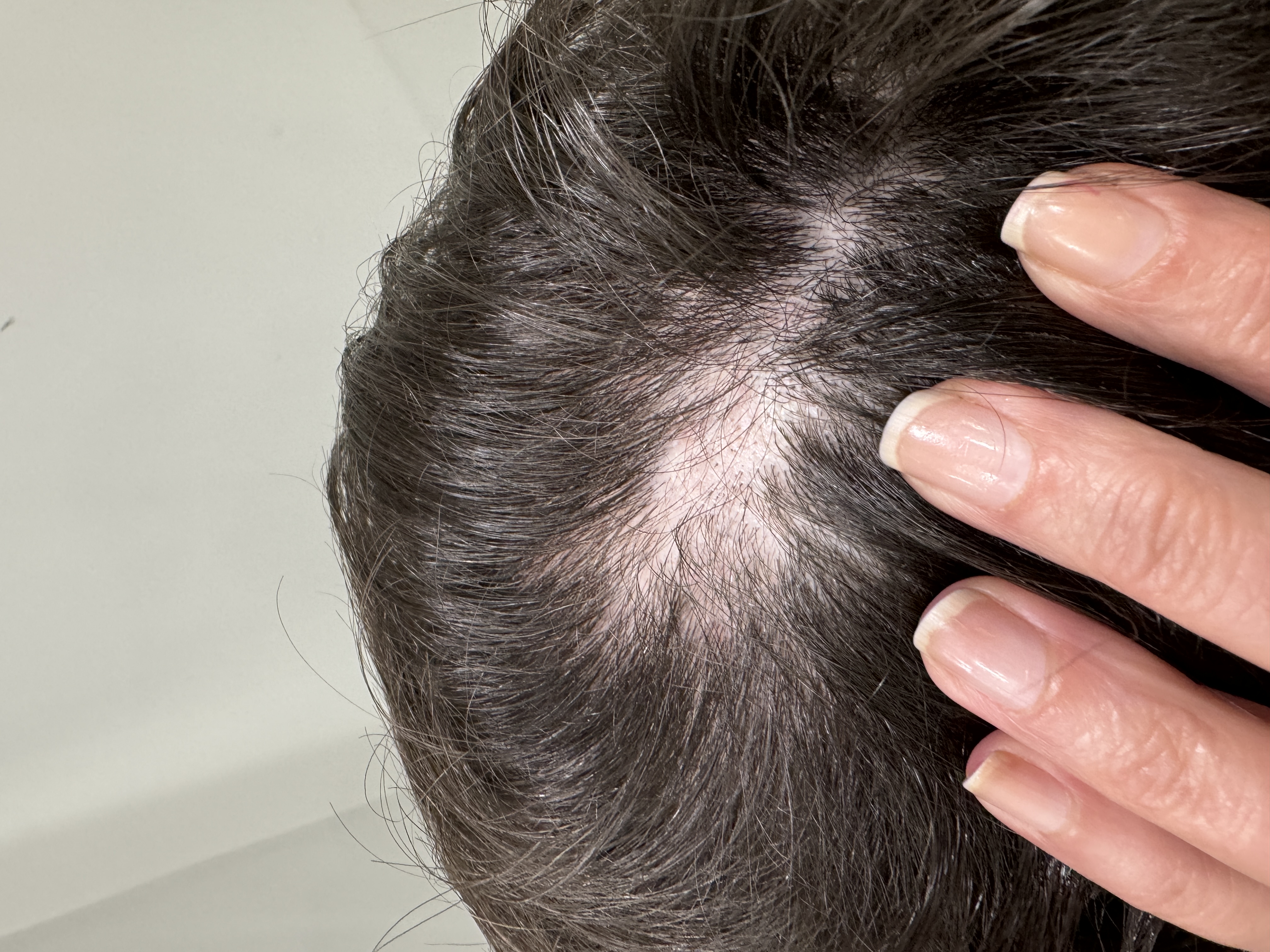
Identifying Symptoms of Alopecia Areata in Kids
Recognizing the signs of alopecia areata in children is very important. This helps with early diagnosis and treatment. The condition usually shows up as smooth, round bald spots on the scalp.
Parents should watch for any strange signs of hair loss. This is important if the hair falls out easily or if there are clear bald spots. Finding it early and getting treatment can help hair regrowth and reduce the emotional effects on children.
Early Signs: What Parents Should Look For
One of the first signs of alopecia areata is bald spots on the scalp. These spots are usually round or oval. They feel smooth and have no hair. The skin under these bald patches often looks normal. There’s usually no redness, scaling, or scarring.
Parents should notice any changes in their child's hair loss. It's normal for kids to lose some hair when brushing or washing, but too much hair loss or clumps of hair could be a problem.
Also, kids with alopecia areata might face a higher chance of getting other autoimmune conditions like atopic dermatitis, which is also called eczema. If a child loses hair and has itchy, red, or inflamed skin, it is important to see a doctor.
Recognizing Different Patterns of Hair Loss
Alopecia areata can show up in different ways. The most common form is patchy alopecia areata. This type causes small, round patches where hair falls out on the scalp. Sometimes, these patches can grow and join together, making larger areas of hair loss.
There are more serious forms of alopecia areata too. Alopecia totalis leads to losing all hair on the scalp. Alopecia universalis is even worse, affecting every hair on the body, like eyebrows, eyelashes, and body hair.
It's crucial to tell alopecia areata apart from other hair loss types. For example, traction alopecia comes from pulling or stress on the hair. This usually happens because of tight hairstyles. Traction alopecia looks like thinning hair or hair loss near the hairline or in places where the hair is pulled tight. Another important factor in recognizing different types of hair loss is to identify the pattern of hair loss, as it can help narrow down the potential causes and guide treatment options.
Exploring the Causes Behind Alopecia Areata
Alopecia areata's exact cause is not known. However, researchers think that both genetics and environment play a role in its development. People who have family members with autoimmune diseases, like alopecia areata, may be more prone to it.
In addition, certain environmental factors could cause the immune system to attack hair follicles. These factors might include stress, viral infections, or some medications. This is especially true for those who are already likely to develop alopecia due to their genes.
Genetic Factors and Alopecia Areata
Research shows that genetics play a big role in alopecia areata, a type of hair loss. People with a family history of this autoimmune disease or other autoimmune diseases are more likely to get alopecia areata.
The specific genes that cause this condition are still being studied. Researchers believe that many genes, not just one, work together to increase the risk. These genes might change how the immune system works, making a person more likely to have autoimmune issues.
The way alopecia areata is inherited is complicated and not completely clear. It is not purely a hereditary disease, which means children of parents with this condition might not get it. However, having a close relative with alopecia areata does make it more likely for someone to lose their hair in this way.
Environmental Triggers and Immune System Response
Genetic predisposition does play a part in alopecia areata. However, environmental factors often cause the condition to start or get worse. These factors may make the immune system go into action. This can lead it to mistakenly attack hair follicles in people who are likely to develop the condition.
Some common environmental triggers related to alopecia areata include stress, viral infections, and certain medications. Emotional stress, whether short-term or long-term, can upset the body's immune balance, potentially leading to autoimmune reactions such as high fever. Viral infections, like the cold or the flu, can also wake up the immune system, potentially leading to damage to hair follicles.
Moreover, some medications, such as certain antibiotics and antidepressants, may cause hair loss as a side effect. They could trigger an autoimmune reaction in people who are already at risk.
Diagnosis Procedures for Alopecia Areata in Children
Diagnosing alopecia areata in children usually includes a physical exam, checking medical history, and sometimes doing extra tests. If parents see strange hair loss in their child, they should talk to a doctor or dermatologist.
The doctor will look at the child's scalp for signs of alopecia areata. They will also ask about the family history of autoimmune diseases. The doctor might suggest tests to check for other issues and to confirm the diagnosis.
When to Consult a Dermatologist
If your child is losing hair, it's very important to talk to their doctor or a dermatologist. A dermatologist is a doctor who focuses on skin, hair, and nail conditions. They can tell the difference between alopecia areata and other hair loss types and can suggest the right treatment options.
You usually need to see a dermatologist if the hair loss is widespread, keeps happening, or comes with other signs like itching, redness, or scaling on the scalp. If the child feels upset about the hair loss, a dermatologist can also help with support and advice.
Getting a diagnosis and treatment for alopecia areata early can help hair regrowth and lower the chance of ongoing issues.
Tools and Tests Used in Diagnosing Alopecia Areata
Dermatologists employ various tools and tests to diagnose alopecia areata accurately. A physical exam is usually the first step, where the doctor visually inspects the scalp for characteristic signs of the condition, such as smooth, round patches of hair loss.
Dermoscopy, a non-invasive technique using a handheld device called a dermatoscope, allows for closer examination of the scalp and hair shafts. This helps identify specific patterns and features suggestive of alopecia areata, enabling a more accurate diagnosis.
Occasionally, blood tests may be ordered to rule out other underlying medical conditions that can cause hair loss, such as thyroid disorders or nutritional deficiencies.
|
Tool/Test |
Description |
|
Physical Exam |
Visual inspection of the scalp for characteristic patterns of hair loss, such as round or oval bald patches. |
|
Dermoscopy |
Examination of the scalp and hair shafts using a dermatoscope to identify specific features associated with alopecia areata. |
|
Blood Tests |
May be performed to exclude other medical conditions that can cause hair loss, such as thyroid disorders or nutritional deficiencies. |
Available Treatment Options and Management Strategies
There is no cure for alopecia areata. However, there are different treatment options to help manage this condition and encourage hair regrowth. The choice of treatment depends on some factors. These include the child's age, the level of hair loss, and any other medical issues.
Treatment options can include topical medications. These are things like corticosteroids or minoxidil. They work by reducing the immune response and helping hair follicles grow. In certain cases, doctors may suggest systemic medications or injections. Usually, a mix of treatments brings the best results.
Current Medications and Topical Treatments
Topical medications are often the first choice for treating alopecia areata in children. Topical steroids come in different strengths. They help reduce swelling and lower the immune response in the affected areas.
Minoxidil is another topical treatment. It is thought to help widen hair follicles and extend the hair growth phase. Minoxidil is approved by the FDA for other types of hair loss, but it is not always effective for alopecia areata.
Sometimes, doctors suggest intralesional corticosteroids. These are injected right into the bald spots. This method helps put more medicine directly on the hair follicles.
Emerging Therapies and Research Directions
Exciting new treatments for alopecia areata are being discovered through clinical trials. Janus kinase (JAK) inhibitors, which were first made for other autoimmune conditions, are showing good results. They are helping people with extensive hair loss from alopecia areata.
These medications work by blocking a pathway in the immune system called JAK-STAT. By doing this, JAK inhibitors can lessen the immune attack on hair follicles, which helps hair regrowth.
Several JAK inhibitors have received FDA approval for adults with alopecia areata. Research is also looking into how safe and effective these treatments are for children. These advancements give hope to both children and adults dealing with alopecia areata. They offer the possibility of better and more targeted treatments, including the use of placebo, in the future. Additionally, for children who experience extensive hair loss, a wig may be necessary. Referral to a psychologist should also be considered when there is significant psychological distress.
Lifestyle Adjustments and Supportive Care for Affected Children
Coping with hair loss can greatly affect a child's feelings. It may make them feel self-conscious, anxious, or socially isolated.
Supportive care is very important to help children deal with alopecia areata. It's key for families to communicate openly and to create a safe space. This allows the child to share their feelings.
Getting help from therapists or joining support groups that focus on alopecia areata can be very useful for children dealing with hair loss. These resources, such as the National Alopecia Areata Foundation and Children’s Alopecia Project, can offer good ways to cope and link children with others facing similar issues. It's important to build self-esteem and resilience while also addressing the psychological effects of hair loss, such as social isolation and humiliation. This helps improve the child's overall well-being.
Conclusion - Hair Patches, Wigs & Hair Toppers
In conclusion, understanding alopecia areata in children is important. Early detection and a good diagnosis are key for treatment options. Parents have a big role in spotting symptoms and supporting their child emotionally. By talking to dermatologists and looking into the medicines that are available, families can handle this condition with care. It's important to remember that alopecia areata is not contagious. With the right plan, children can deal with its effects well. Stay informed, ask for expert help, and give love and support to help your child manage alopecia areata positively.
Frequently Asked Questions
Can children outgrow alopecia areata?
The outlook for kids with alopecia areata can be different. Some may see their hair grow back on its own. Others might have hair loss come back or continue losing hair. A few things can affect this outlook. These include the child's age, family history, and how much hair they have lost.
Are there any side effects to the treatments available?
All treatments for alopecia areata have possible side effects. Topical steroids might make the skin thinner or change its color. Immunotherapy can cause allergies. It is important to talk about the risks and benefits of all treatment options with your child’s doctor. This helps you make informed choices.
How can parents support their child emotionally?
Parents can give important emotional support. They can do this by encouraging their child to share their thoughts. It's also helpful for them to acknowledge their child's feelings. Parents can assist their kids in finding ways to handle the social and psychological effects of hair loss.
Is alopecia areata contagious?
Alopecia areata is an autoimmune disease. This means it happens when the body's immune system attacks its own hair follicles. It is not contagious. You can't catch it from someone else. It is not caused by germs, bacteria, or viruses. You cannot spread it through touch or by sharing personal items.

